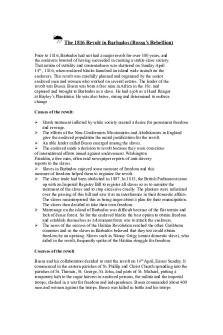Rebellion Of 1798 2 - History Of Ireland HIST-38000 PDF

| Title | Rebellion Of 1798 2 - History Of Ireland HIST-38000 |
|---|---|
| Author | sarah pajeau |
| Course | History Of Ireland |
| Institution | Lewis University |
| Pages | 3 |
| File Size | 33 KB |
| File Type | |
| Total Downloads | 102 |
| Total Views | 125 |
Summary
History Of Ireland HIST-38000...
Description
Sarah Pajeau Irish Rebellion of 1798 The Rebellion of 1798 was an uprising against the British rule that began because of the oppression they were receiving by the British government. The British had occupied the small country of Ireland since the twelfth century and were intending to control it even longer. In the rebellion there were all types of people fighting against Britain. There were rich, poor, Catholic, and even Protestant. Poor people, who made up most of the population, and Catholics did not have a say on what was happening with the parliament. Catholics could not even be in parliament. There were many laws about what the Catholic people could and could not do. People wanted change, rights, liberty, and equality. The rising of the United Irishmen happened on May 23rd, 1798. The United Irishmen were inspired by the American Revolution and French Revolution. They were a liberal political organization that fought for parliamentary reform. Eventually they evolved into a revolutionary republican organization because of their admiration for the American and French Revolution, who began in Belfast in the year of 1791. Eventually they began seeking French help for their own revolution. The United Irishmen were usually a peaceful group but they wanted and needed a lot of change in their country. On May 25, 1798, Carlow joined the rebellion. An attack on Carlow took place on their four main streets, which were Tullow Street, Burrin Street, Dublin Street, and across Graigue bridge, which all met up on Potato Market. When the rebels came to Carlowtow, they were greeted by Catholic townspeople and other people who secretly
came the night before to help. When they reached Potato Market they ere shot from the British who were hiding in second story windows waiting for the Irish arrivals. 200400 Irish were killed in that shooting. An estimation of 500 people were killed in the Battle of Carlow. The ones who were killed in this battle were then buried in a mass grave, also known as a “croppy hole,” which is still there today. About 30,000 people were killed overall throughout the whole rebellion.
Work Cited Moody, T. W., and F. X. Martin. "The Age of the Penal Laws." The Course of Irish History. Cork: Mercier, 2011. 176-88. Print....
Similar Free PDFs

CRY-of-Rebellion - nnnkjnjnknn
- 2 Pages

Summary-Cry of Rebellion
- 3 Pages

History OF Badminton 2 1
- 10 Pages

History of English chapter 2
- 3 Pages

Unit 2. Ireland
- 8 Pages

Ireland essay - Grade: 2:1
- 2 Pages

1798 - sjjjjjjjjjscnccncncncncnc
- 2 Pages

The History Of Probation
- 4 Pages

Brief history of Psychology
- 4 Pages

History of swimming timeline
- 1 Pages
Popular Institutions
- Tinajero National High School - Annex
- Politeknik Caltex Riau
- Yokohama City University
- SGT University
- University of Al-Qadisiyah
- Divine Word College of Vigan
- Techniek College Rotterdam
- Universidade de Santiago
- Universiti Teknologi MARA Cawangan Johor Kampus Pasir Gudang
- Poltekkes Kemenkes Yogyakarta
- Baguio City National High School
- Colegio san marcos
- preparatoria uno
- Centro de Bachillerato Tecnológico Industrial y de Servicios No. 107
- Dalian Maritime University
- Quang Trung Secondary School
- Colegio Tecnológico en Informática
- Corporación Regional de Educación Superior
- Grupo CEDVA
- Dar Al Uloom University
- Centro de Estudios Preuniversitarios de la Universidad Nacional de Ingeniería
- 上智大学
- Aakash International School, Nuna Majara
- San Felipe Neri Catholic School
- Kang Chiao International School - New Taipei City
- Misamis Occidental National High School
- Institución Educativa Escuela Normal Juan Ladrilleros
- Kolehiyo ng Pantukan
- Batanes State College
- Instituto Continental
- Sekolah Menengah Kejuruan Kesehatan Kaltara (Tarakan)
- Colegio de La Inmaculada Concepcion - Cebu





